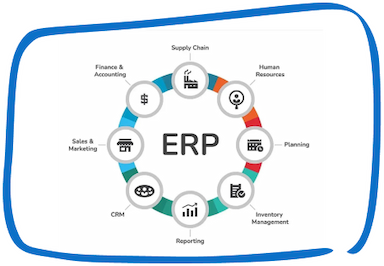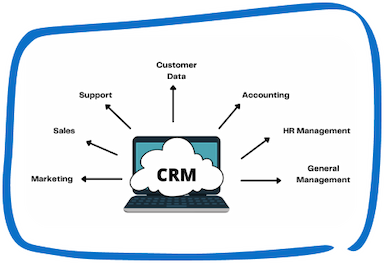ERP is a software application that unifies all aspects of a business’s operations, including finance, supply chain, manufacturing, human resources, and customer relationship management. ERP integration is the process of integrating ERP software with other business applications or systems. A business can benefit significantly from a successful ERP integration, but there are also specific challenges involved. In this blog post, we will discuss ERP system integration strategy, challenges, benefits, and key types.
ERP Integration Strategies
ERP software integration strategy involves defining the integration’s objectives, selecting the best integration strategy, and developing an implementation plan. The most typical integration objectives are to increase operational effectiveness, improve data accuracy, and reduce cost, though they might vary depending on the organization’s needs.
The integration strategy chosen must align with the objectives and resources of the company. There are three primary methods of ERP integration: point-to-point, middleware, and service-oriented architecture (SOA).
Point-to-point
Point-to-point integration involves connecting two systems directly, usually through custom coding. When integrating two systems, this technique is simple and efficient, but as the number of integrated systems increases, it can become complex and challenging to maintain.
Middleware integration
Middleware integration is the process of connecting multiple systems using middleware software, such as an Enterprise Service Bus (ESB). It offers a centralized hub for controlling and coordinating system communication. Compared to point-to-point integration, this method is more adaptable and capable of handling more complex integration scenarios.
SOA integration
Using web services, SOA integration exposes ERP software functionality as services that may be used by other systems. Compared to the previous techniques, this one offers more flexibility, agility, and scalability, but it also demands more planning and design.
An implementation strategy should be created after the integration technique is decided upon. This strategy should specify which data will be integrated, define data governance guidelines, and test the integration before going live.
Challenges of ERP Software Integration
Organizations may face a variety of challenges in their efforts to successfully integrate ERP. Among the principal difficulties are:
Data complexity
Because ERP systems can contain a lot of data and are complex, careful mapping and transformation are necessary before integration. According to a study, data integration fails for the first time in 50% of cases. In defense, it should highlight that poor planning and communication are to blame for the failure. n order to overcome problems, careful planning, positive interactions with coworkers, and gaining knowledge about all aspects of integration are helpful.
Integration costs
Projects involving integration can be expensive, particularly when there is a need for custom development. It can cost three to four times more, on average. Also, you must modify ERP software to meet your business needs, which will increase the cost. On the bright side, investing in a costly ERP solution is worthwhile. An ERP tool’s implementation will gradually lower operational costs. Improving production and sales will raise your return on investment.
Resistance to change
While integrating new technologies, it can be difficult for people to change, and employees may need the training to adapt to new workflows. Training is necessary for the adoption of a new ERP. It can take a lot of time and effort to persuade functional units and workers to change their work practices and adopt new ERP systems.
Data security
The danger of data breaches or unauthorized access to sensitive data can increase with the integration of multiple systems. ERP system keeps the data online. In the ERP tool, businesses store all confidential material. That frequently happens if you supplement the current ERP software with new technology. So, to protect your private data, you will need to double-secure everything, which will be incredibly expensive.
System compatibility
Integration might be challenging because various systems may use different data formats or protocols. Because different systems use different technologies and data structures, system compatibility in ERP software integration is difficult. Systems can experience compatibility problems at various levels, including APIs, databases, and user interfaces, which makes it challenging for systems to communicate effectively. Organizations must carefully design their ERP integration strategy, carry out compatibility checks, and spend money on middleware or integration software to overcome this difficulty.
Some advantages of ERP integration include:
Improved data accuracy
Integrating different systems can eliminate data duplication and errors, ensuring accurate data for decision-making. There is a chance to reduce human error. Because ERP system integration can raise the level of automation along corporate operations. Automation is quite advantageous because mistakes and emails sent to the wrong client might have a bad effect on your organization.
Process automation
Integration can eliminate the need for manual data entry, which can save time and lower the possibility of errors. A centralized platform eliminates the need for manual data transmission and provides easy access to a single database throughout the organization.
For instance, in a manufacturing company, the ERP software may instantly process a new purchase request and provide it to the shipment, accounting, and inventory departments.
Better collaboration
By enabling access to the same data across departments, integration can enhance coordination and communication. One essential element of ERP integration is a centralized database. With a single database, users from different departments can access current information. Several systems can receive data at once. A centralized database features a modern, intuitive user interface.
Improved efficiency
Integration can streamline processes and reduce the amount of time and resources needed for manual tasks by automating procedures. Also, the automation of repetitive tasks like data entry saves up workers’ time for complex tasks.
These are the tasks that demand more time and focus to finish. Employees can devote more time to creating plans for increasing sales when they are not required to perform manual data entry.
Improved customer service:
Integration can deliver real-time data, enabling companies to better serve customers and respond instantly to their needs. By enabling organizations to create more customized experiences, the integration of ERP systems can greatly enhance customer service. Businesses can accelerate order processing and delivery by streamlining their inventory and order management procedures with ERP system integration. Furthermore, ERP software can offer organizations real-time information about customer behavior. This allows them to proactively handle problems and raise client satisfaction levels.
Key types of ERP software integration
E-commerce ERP integration
Integration of an eCommerce site for a business with a backend inventory and accounting system is referred to as eCommerce-ERP integration (i.e. ERP.) Data can travel from one of these systems to another with effective system integration. The ERP software keeps the data permanently after it is entered. A company can manage its database more effectively by connecting an ERP tool with an eCommerce website.
ERP integration gives businesses a simple approach to managing their eCommerce site as well as establishing close relationships with their suppliers and customers. A good ERP-eCommerce integration streamlines the front-to-back flow of business processes. Businesses can quickly transfer information, including sales orders, product availability, customer profiles, pricing, and more, with this ability to fulfill demand.
Business intelligence integration
One of the most helpful technologies now on the market is business intelligence (BI) software. Business intelligence (BI) software assists organizations in finding insights that result in profitable future ventures or business practices by gathering and analyzing internal data. New software implementations frequently start with the insights gained from BI software data. These priceless insights are made accessible to any authorized employee at any time by linking your BI system with your ERP solution.
Project management integration
A project management option is present in many ERP systems. It’s doubtful that the project management tool included in an ERP tool is as complex as the standalone tool you’re presently using if you already use a third-party project management program. The ability to collect all of your business tasks, processes, and workflows in one location makes project management integration so helpful. An employee can always see what projects are completed, what projects are ongoing, who is working on them, and what projects are upcoming. This can save a huge amount of time. For instance, you can observe which developer is working on a bug fix or which sales representative is contacting a lead.
CRM integration
A successful business must have a strong communication system and offer top-notch customer service to the customers it serves. For you to get the most out of your customer contacts, you need “best of type” customer relationship management (CRM) technology. It’s because offering the best customer service can give you a significant competitive edge. However, that might be the most simple integration on the list due to the relative prevalence of CRM and ERP connections. Furthermore, you are strongly encouraged to integrate your CRM program with your ERP tool due to a significant link between demand and supply. This CRM and ERP interface allows for a more efficient sales and marketing process.
Human resources Integration
Since the HR department is one of any industry’s most extensive back-office responsibilities, a productive workflow is essential. After all, regardless of title or leadership position, the HR department is the one that interacts with every employee in your business. You can maintain track of and speed up time-consuming back-office processes by integrating your HR provider’s skills into the ERP system’s workflows.
Last thoughts
For businesses to increase productivity, streamline procedures, and achieve operational excellence, an ERP integration strategy is necessary. While better decision-making, enhanced transparency, and optimized processes are all advantages of ERP integration, difficulties including high prices, difficult customization, and resistance to change should be carefully addressed to ensure effective implementation.
To know more about Elate ERP you can contact us right now.
Speak with Our Team!
4.9 Stars
1k+ reviews on






